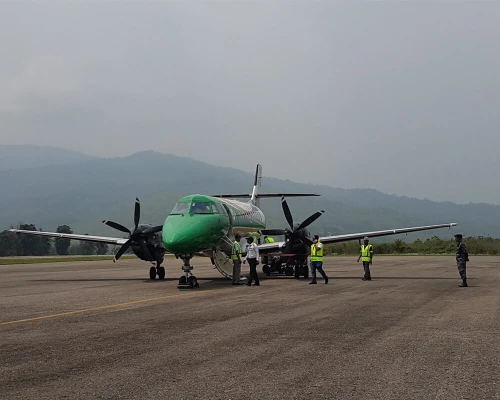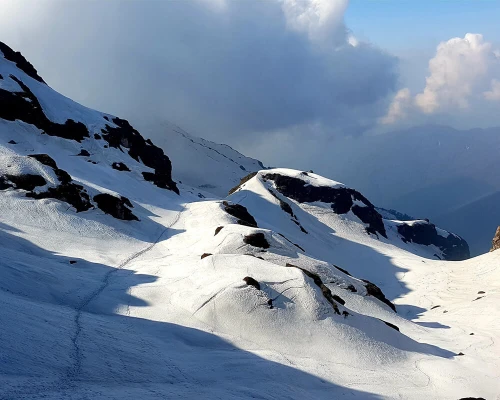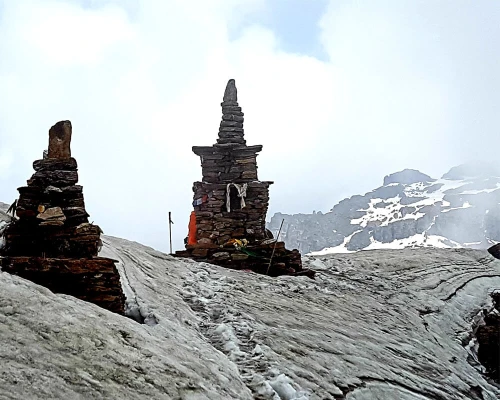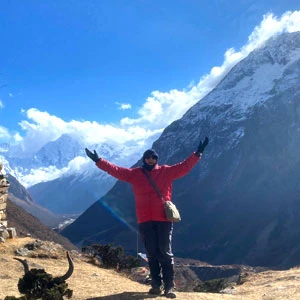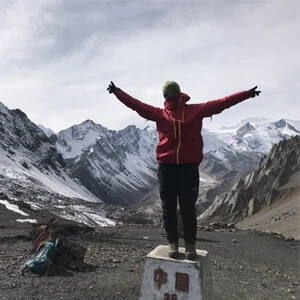Makalu Barun National Park
Established in 1992, Makalu Barun is one of Nepal’s newest national parks. The park represents the world’s only protected area with an elevation gain of more than 8000 meters, with Makalu, the world’s fifth-highest peak, at its core. It encloses a diverse assortment of flora and fauna that ranges from tropical forests in the south to the soaring snow-capped backdrop of the Himalayas in the north.
The Makalu Base Camp Trek is a less frequented route due to its relative isolation and remote setting, offering an ideal opportunity for hardier or more experienced trekkers to explore a pristine region of wide-ranging natural beauty and glorious scenery, including Everest, all while in the quiet comfort and solitude that comes from being well away from the madding crowds.
Journey From Kathmandu To Makalu Base Camp
The Makalu Trek begins with a scenic flight to Tumlingtar, from where we’ll head out toward the village of Num (1560 m) the following day. Along the way, we’ll encounter a ridgeline with a steeply undulating trail snaking along its length that affords some of the finest panoramic views you’re ever likely to come across in the Himalayas. From there, we’ll make our way to Seduwa (1500 m), where we will call in at the local outpost of the national park to register and obtain the necessary permits before moving on again towards Tashi Gaun (2100 m), the last permanent settlement in the valley.
The trail continues onward and upward to the next goal, the high pass of Shipton La, named after famed British alpinist Eric Shipton, who used the route with Edmund Hillary in 1952 to make a survey of Everest for the following year’s successful expedition to the mountain. Finally, comes the trek’s ultimate goal, Makalu Base Camp itself, from where you’ll be presented with spectacular views of the southern face of the mountain, as well as a glorious panorama of Everest and Lhotse reaching toward the heavens. After spending an appropriate amount of time breathing in and memorizing every last memorable aspect of the view, it will be time to reluctantly head back to Tumlingtar, with fresh aspects and experiences to bring new perspectives to the journey.
Makalu Trek Adventure Difficulty
The Trek to Makalu Base Camp is the grandeur result of nature’s majestic gifts and raw challenges amidst the trails. As you might have heard, this particular trek is one of the most strenuous trekking trails in Nepal that pushes the limit of both your physical endurance and mental fortitude.
But you might have a question. The Makalu Trek, unlike any other routes, does not go to higher altitude levels above 4,870 meters so, what makes it strenuous? Well, for starters, the constant elevation gain and loss makes this trek physically demanding. Just within five days of your trekking (including the flight day from Kathmandu to Tumlingtar), you will reach the highest pass of this trek, the Shipton La Pass at an altitude of 4,200 meters.
To elaborate, the trekking distance from one point to another is usually short, but it gains or loses altitude really fast. For instance, the first day of trekking to Seduwa is only 4.9 kilometers but involves an elevation gain of 786 meters and an elevation loss of 322 meters. Similarly, the trek from Tashi Gaon to Khongma Danda is 5.85 kilometers but has an elevation gain of 1,368 meters.
Hence, with this constant change in altitude levels and spending most of the trek above 3,500 meters, the risk of altitude-related issues remains high. Since your body does not get enough time to adapt to its surroundings, you may start to face symptoms such as headaches, fatigue, shortness of breath, and nausea. Therefore, pacing your body and keeping yourself hydrated while properly acclimatization is crucial. It is not an option but a necessity.
Another concerning factor that contributes to the difficulty of the Makalu Base Camp is the terrain. Starting from the lush greenery of verdant valleys, subtropical forests, and meadows, the route takes you through dynamic landscapes.
Here, a lot of the trekking trails consist of steep ascents and descents with stone staircases. Some staircases are almost 50 degrees. Furthermore, the paths are uneven and rocky, with the presence of the Barun River at occasional points making the path more complex. Altogether, the landscapes are a bit gentler before reaching the base camp; however, the risk of altitude sickness will be there.
Lastly, the remoteness and isolation of this trekking route can be a double-edged sword. While you will find peace and tranquility along the way, the facilities are limited and basic compared to classic trekking routes such as the Everest Base Camp Trek, Annapurna Base Camp Trek, Langtang Valley Trek, etc.
Overall, the combination of changing altitude levels, high passes, challenging terrain, remoteness of the region, and weather conditions all contribute to the trek’s demanding nature.
Best Time To Trek To Makalu Base Camp
The Trek to Makalu Base Camp takes you to the foothills of the world’s fifth-highest peak, Mount Makalu. With the unique topography of the region, timing is a pivotal factor in making this trek worthwhile.
Additionally, weather conditions have a direct impact on the outcome of the journey regarding visibility, accessibility, and difficulty. Nepal Trekking Experts recommend you embark on the Makalu Region Trek during Autumn and Spring for optimal views, trail conditions, and enjoyment.
The Autumn season, starting from September to November, is the post-monsoon season that offers excellent visibility, clear skies, and stable weather. After months-long downpours, it brings a fresher perspective of the region, washing away the dirt and providing a prime window with the panoramic views of Mt. Makalu, Mt. Lhotse, Mt. Manaslu, and other surrounding peaks.
Furthermore, the air is crisp and cool during Autumn with the backdrop of crystal clear blue skies. Generally, the temperature during this season ranges from 10°C to 20°C at lower altitudes and from -5°C to 10°C at higher altitudes. If you book your trek in October, you will also get an opportunity to witness the greatest festivals of Nepal, Dashain and Tihar.
Indeed, Autumn sets a clear mood with festivities rolling by. Not to mention, this particular season is also a spectacular chance for photography.
Moving on to another favorable season, Spring brings calm weather with warm and sunny days. Usually, this time of the year brings bright days and comfortable temperatures that range from 10°C to 20°C at lower altitudes and from -5°C to 10°C at higher altitudes.
Here, one of the major highlights during the Spring season is the vibrant colors that it brings with itself. If you are trekking at this time of the year, you will see lush greenery and colorful blooms of rhododendron and magnolia. In the meantime, you will also have a higher chance of seeing the wildlife during the season, as most of them come out from their long winter sleep.
Having said that, the Spring season brings the most favorable conditions, so we recommend you schedule your travels during the middle of April to enjoy this season in its prime. Usually, even till early April, you will see some parts of the trails that are still covered in snow. Likewise, the Monsoon / Summer season starts early at the Makalu Base Camp Trekking trail, and it is the second wettest area in Nepal.
Talking about the Monsoon season, it brings constant heavy rainfall in the area, making it hot and humid. The temperature often ranges from 15°C to 25°C at lower altitudes and from 5°C to 15°C at higher altitudes.
During this time, the region is typically covered with heavy clouds of rain and fog, hence limiting your visibility and obstructing the views of the Himalayas. In addition to that, the continuous downpour makes the trail much more slippery and muddy, making the terrain more challenging.
While this season brings the best out of water bodies, it always poses a risk of potential floods or landslides in the region. If you have trekking scheduled for this season, make sure to prepare well with the necessary items and be prepared for issues such as flight cancellations or blocked paths. Hence, a buffer period is always recommended to add to your itinerary.
Lastly, the Winter in the Makalu Base Camp is harsh with freezing temperatures ranging between 5°C to 15°C at lower altitudes and from -15°C to 5°C at higher altitudes. Similarly, this season brings heavy snowfall, often blocking the trails at higher altitudes.
Here, the winter season shines a completely different light on this trail, offering stunning views of the snow-capped peaks. While this trek is still doable with the right gear and prior experience, we do not recommend it to first-time or beginner trekkers.
Permits Required
To ensure a smooth and hassle-free journey to the Makalu Base Camp, you will need two trekking permits.
The first permit is the Makalu National Park Permit, which grants access to the protected areas of the Makalu-Barun National Park. This will cost you NRs 3,000. Likewise, the second permit you will need is the Makalu Rural Municipality Area Permit which allows you to trek through the local administrative areas of Makalu. This particular permit will cost you NRs 2,000.
Altogether, you will get these permits from the Nepal Tourism Board in Kathmandu or through the local trekking agency that you are trekking from. Additionally, you will require your original passport with a valid visa and a pair of passport-size photos to obtain this permit.
How can I book the Makalu Barun National Park Trek?
To book your trek with us, you have to send a 10% deposit of the total cost. Please also forward a copy of your passport, a passport-sized photo, and full flight details if and when available. For your convenience, you may forward the deposit online through our website. It is completely safe, and as soon as you make it, you will get an automatic receipt in your inbox. The rest of the payment can be paid upon arrival.


